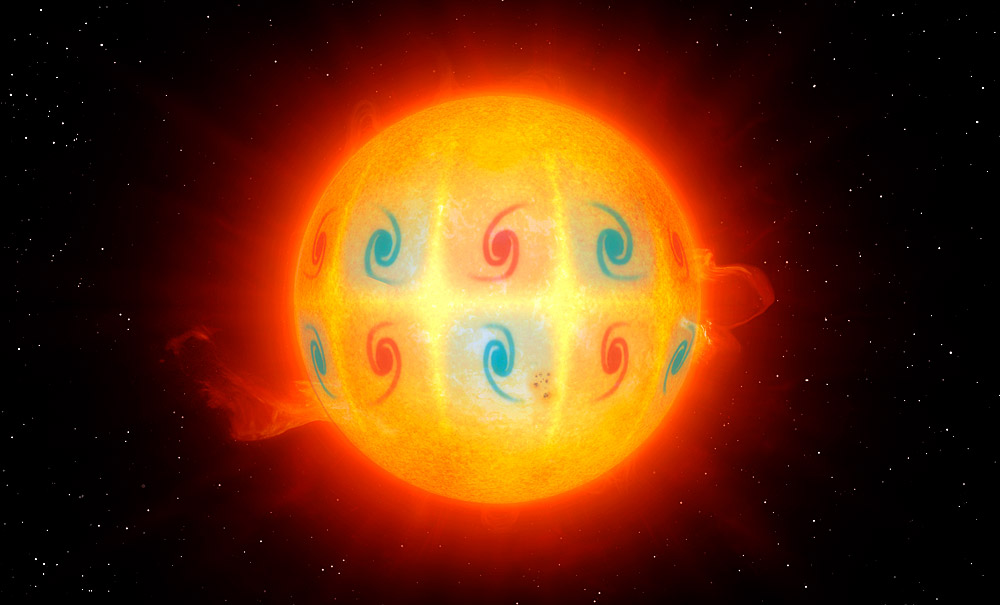Unexplained swirls: Astronomers have discovered a new type of ripple on the Sun that cannot be explained by current models. High-frequency waves create asymmetric vortices near the equator and race against the direction of rotation around our star. They are moving three times faster than previously known waves with a similar phase, the researchers report in the journal Nature Astronomy. Its cause is completely unknown.
The surface and inner workings of our Sun are shaped by many currents and waves. Including wavy ones Instability In the local plasma, but also in the huge vortex Rossby waves And two huge ones inversion currents in the depths of the sun. They are caused by temperature differences in the interior of the Sun, but also by the complex interactions of plasma with the Sun’s magnetic field, the Sun’s rotation and gravity.
A ring of whirlpools
But now researchers led by Chris Hanson of New York University in Abu Dhabi have discovered a previously unknown waveform on the sun that eludes conventional explanations. For their study, they evaluated long-term data from two solar observatories in the form of Doppler recordings over 24 years. This data uses spectroscopy to visualize stellar vibrations and the motions of plasma on the Sun’s surface.
Astronomers have identified a new type of plasma wave along the solar equator. This manifests itself in a set of vortices that surround the entire Sun. These vortices rotate clockwise and counterclockwise and are located on either side of the equator. The opposite eddies there are each asymmetric, the team reported.
Faster than theory allows
Also interesting: the newly discovered solar vortices migrate around the star in the opposite direction of the Sun’s rotation. Although their phase corresponds to the phase of the already known Rossby waves, the vortices move around the Sun three times faster than these. “The classical hydrodynamic Rossby wave theory cannot explain equatorial high-frequency retrograde (HFR) waves,” Hanson and colleagues stated.
But what is the cause of these waves then? “Theoretically, it is possible that the coupling of Rossby waves with other phenomena could lead to such an increase in phase velocity,” the researchers explain. “So we examined three of the most plausible candidates for such an interaction in more detail.” They include the interaction of Rossby waves with the Sun’s magnetic field, the interaction with the Sun’s gravity, or the combined effect of plasma flow caused by heat and the rotational Coriolis force.
It has nothing to do with the magnetic field, gravitational waves, or Coriolis force
But in all three cases, the astronomers were unable to find any connection to the high-frequency bouncing waves. As they explain, in the case of Rossby’s magnetic field coupling, fluctuations during the solar cycle should be noticeable. But there was no evidence for this in the data covering two such good cycles. On the other hand, gravitational waves should be the same on both sides of the equator, but this is not the case for HFR waves.
The vortices that occur as a result of the effect of the Coriolis force on objects with layers will be more similar: “They form vertical asymmetric equatorial plumes that appear on the surface of the Sun in the form of vortices rotating north and south in opposite directions,” according to the researchers explain. “This is exactly what we see for the high-frequency backwards waves.” However, most models predict a progressive motion of such vortices – with the Sun’s rotation rather than its opposite.
“real puzzle”
Thus, the newly discovered solar waves do not fit into any of the usual categories: “HFR waves do not appear to be caused by any of the processes investigated,” Hanson says. “This raises a whole host of new questions.” It is clear that there are components that are missing or insufficiently defined in the standard models of heliophysics. The next step was to check if there were parameters in the known equations that might explain the mysterious vortices after all.
“The very existence and cause of these HFR patterns is a real mystery,” Hanson’s colleague Shravan Hanasoge says. “This could point to exciting physical effects and shed new light on what’s going on inside the Sun, which is invisible to us.” (Nature Astronomy, 2022; doi: 10.1038/s41550-022-01632-z)
Source: New York University

“Social media evangelist. Baconaholic. Devoted reader. Twitter scholar. Avid coffee trailblazer.”








More Stories
Longest jets in the universe discovered – giant particle streams as long as 140 Milky Way galaxies in a row
New method reveals 307 supernova remnants
Snapchat is upping the ante on augmented reality glasses